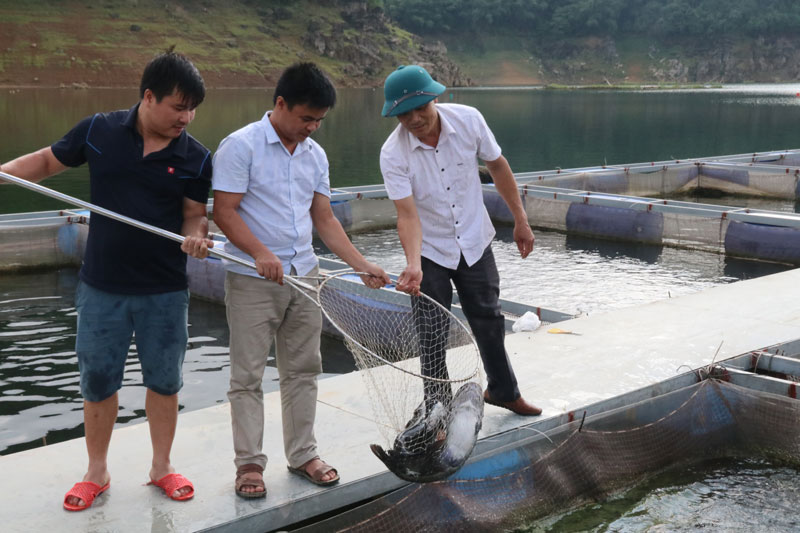
(HBO) - Hoa Binh Lake is large, clean, and rich in resources that make it highly suitable for the development of raising fish in cages. In recent year, Hoa Binh City and the four districts of Cao Ohong, Da Bac, Tan Lac, and Mai Chau have paid attention to investment in cage fish farming projects. A number of communes in the Hoa Binh Lake area have seen the practice booming; they include Thung Nai (Cao Phong), Ngoi Hoa (Tan Lac), Hien Luong, Tien Phong, Vay Nua (Da Bac), Phuc San, and Ba Khan (Mai Chau).

Residents of Hien Luong commune invest in cage fish farming on the
lake.
The standing board of the Party Committee of Hoa Binh
province issued Resolution 12-NQ-TU on June 13, 2014 on the development of cage
fish farming on the lake area for 2014 – 2020. The document set the goals of
developing 3,500 fish cages that produce 5,600 tonnes of fish and create
livelihoods for 2,800 people by 2020. It also aimed at forming production models
linking firms with farmers and cooperatives, thus creating concentrated
production areas and effective aquaculture production chains.
The province is home to 35 businesses, cooperatives and family-based
farms engaging in large-scale intensive farming of fish in cages. Among them,
two firms have invested in over 200 modern fish cages, resulting in high
productivity and quality products. Most of the cages used in the practice are
now made of iron instead of bamboo with the standard volume of 70 – 100 m3
each. Meanwhile, almost all participating households have met technical
specifications and followed safety regulations. Seven enterprises have signed
cooperation contracts with local farmers to raise VietGap-standard fish in
cages. Businesses also commit to buy all fish from farmers.
In addition, Hoa Binh has successfully built a chain of safe
fish products from cage farming on Da River. The province now has 4,250 fish
cages, up 1,933 cages from 2015 and surpassing Resolution 12’s goal set for
2020 by 750 cages. Under the resolution’s policy, 2,602 cages or 56.9 percent
of the total has received support./.
According to data from the Hoa Binh Provincial Party Committee, the industrial production index for the first six months of 2025 is estimated to have increased by 20% compared to the same period last year. This marks the highest year-on-year growth rate for this period since 2020.
In the first six months of 2025, Hoa Binh province’s export turnover was estimated at 1.145 billion USD, marking an 18.11% increase compared to the same period in 2024. Import turnover was estimated at $ 804 million, a 17.15% increase, which helped the province maintain a positive trade balance.
The lives of the ethnic minority farmers in Tan Lac district have gradually improved thanks to the new directions in agricultural production. This is a testament to the collective strength fostered through the professional associations and groups implemented by various levels of the district’s Farmers’ Union.
With the motto the "product quality comes first,” after nearly one year of establishment and operation, Muong village’s Clean Food Agricultural and Commercial Cooperative, located in Cau Hamlet, Hung Son Commune (Kim Boi district), has launched reputable, high-quality agricultural products to the market that are well-received by consumers. The products such as Muong village’s pork sausage, salt-cured chicken, and salt-cured pork hocks have gradually carved out a place in the market and they are on the path to obtaining the OCOP certification.
In the past, the phrase "bumper harvest, rock-bottom prices" was a familiar refrain for Vietnamese farmers engaged in fragmented, small-scale agriculture. But today, a new spirit is emerging across rural areas of Hoa Binh province - one of collaboration, organisation, and collective economic models that provide a stable foundation for production.
Maintaining growing area codes and packing facility codes in accordance with regulations is a mandatory requirement for agricultural products to be eligible for export. Recently, the Department of Agriculture and Environment of Hoa Binh province has intensified technical supervision of designated farming areas and packing facilities to safeguard the "green passport" that enables its products to access international markets.



